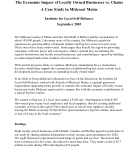The town of Homer, Alaska, has capped retail store sizes at no more than 20,000 square feet in its central business district and 40,000 square feet in other commercial areas. The measure will remain in effect until the Planning Commission implements permanent regulations setting impact standards and size limits for large-scale retail, expected within six months.
Homer, a community of 4,700 people on the breathtaking Kenai Peninsula, has no stores over 20,000 square feet, few chain retailers, and a multitude of healthy, locally owned businesses. Economic data reveal that the area has a larger concentration of small businesses than the rest of the peninsula, and higher sales per square foot.
Last November, the giant supermarket chain Kroger caused an uproar when it announced plans to build a 94,000-square-foot Fred Meyer store in an area the city hoped to develop as a community green space and town square. “The town center should reflect the people who live and work here,” said resident Steve Powell. “There’s nothing about Fred Meyer that reflects the town’s heart or history.”
The City Council passed a temporary moratorium on large-scale retail development and appointed a task force to recommend criteria and regulations for large stores.
The task force has drafted an ordinance for the Planning Commission to consider. It would require retail developments over 15,000 square feet to undergo a review and meet standards governing visual, traffic, environmental, community, and fiscal impacts. The community section includes impact on scenic and historic resources, employment, the downtown business district, local character, and surrounding towns. The fiscal impact section evaluates the development’s projected tax revenue, demand on city services, and effect on nearby property values.
The ordinance seeks to prevent the construction of more retail space than the town can support. It reads: “The applicant shall demonstrate that the project will contribute to the financial health of Homer’s overall economy and that it will not precipitate the decline of existing retail business. The project shall demonstrate that . . . approximate annual sales per retail square foot within the City of Homer will not decrease more than one Standard Deviation. The Standard Deviation is the most stable measure of variability and it is calculated using Homer Gross Retail Sales and Homer’s annual Retail Space as obtained from the Kenai Peninsula Borough Community and Economic Development Division for the five most currently available years.”
Developers pay a permit fee of $300 per 1,000 square feet to cover the city’s cost of evaluating a project’s impacts.
The Planning Commission is expected to consider the measure in the next few months. In addition to the impact review ordinance, it may also opt to make the size limits permanent.
More:



